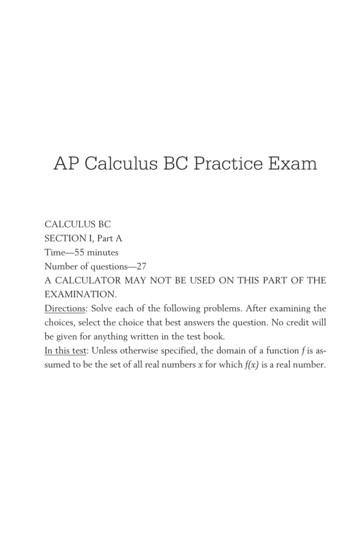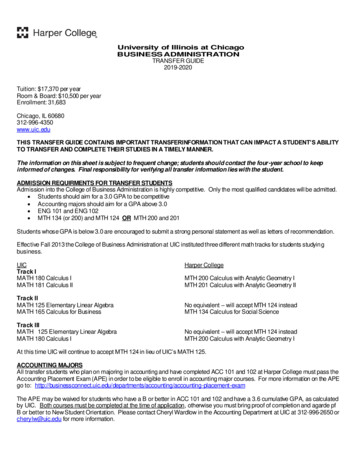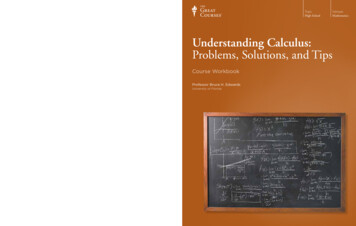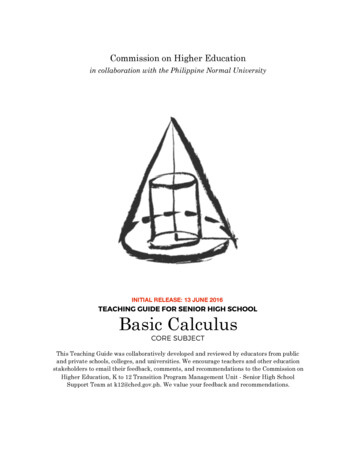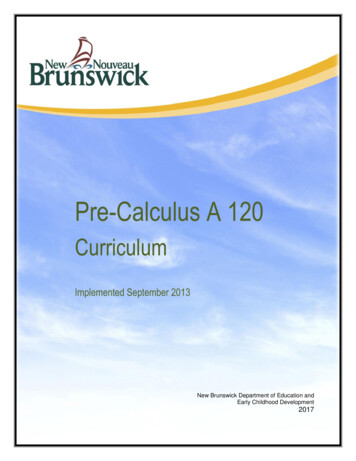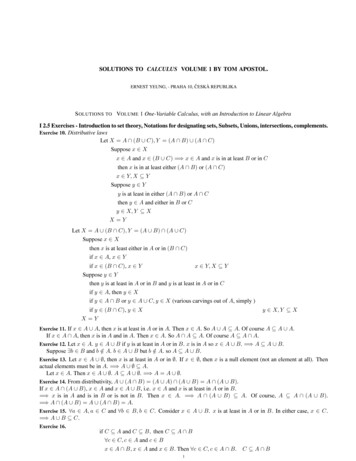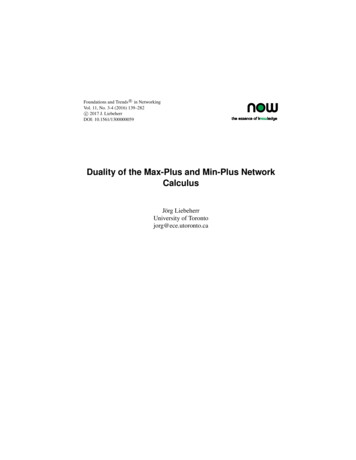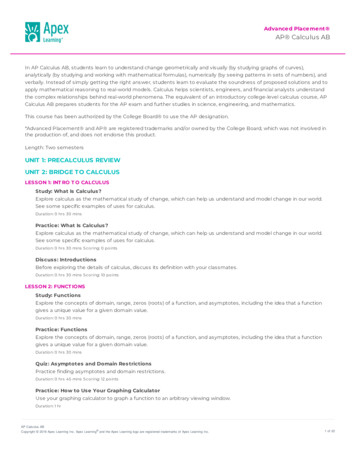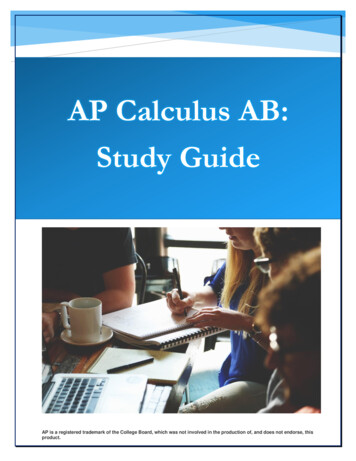
Transcription
AP Calculus AB:Study GuideAP is a registered trademark of the College Board, which was not involved in the production of, and does not endorse, thisproduct.
Key Exam DetailsThe AP Calculus AB exam is a 3-hour and 15-minute, end-of-course test comprised of 45multiple-choice questions (50% of the exam) and 6 free-response questions (50% of the exam).The exam covers the following course content categories: Limits and Continuity: 10–12% of test questionsDifferentiation: Definition and Basic Derivative Rules: 10–12% of test questionsDifferentiation: Composite, Implicit, and Inverse Functions: 9–13% of test questionsContextual Applications of Differentiation: 10–15% of test questionsApplying Derivatives to Analyze Functions: 15–18% of test questionsIntegration and Accumulation of Change: 17–20% of test questionsDifferential Equations: 6–12% of test questionsApplications of Integration: 10–15% of test questionsThis guide offers an overview of the core tested subjects, along with sample AP multiple-choicequestions that are like the questions you’ll see on test day.Limits and ContinuityAround 10‒12% of the questions on your AP Calculus AB exam will feature Limits andContinuity questions.LimitsThe limit of a function f as x approaches c is L if the value of f can be made arbitrarily close to Lby taking x sufficiently close to c (but not equal to c). If such a value exists, this is denotedlim f ( x) L . If no such value exists, we say that the limit does not exist, abbreviated DNE.x cLimits can be found using tables, graphs, and algebra.ExampleSome values of a function are given in the table .012.5041.12.513
Based on these values, it appears that lim f ( x) 2.5 , since the values of the function arex 1growing close to 2.5 as c approaches 1.Important algebraic techniques for finding limits include factoring and rationalizing radicalexpressions. Other helpful tools are given by the following properties.Suppose lim f ( x) L , lim g ( x) M , lim h( x) N , and a is any real number. Then,x cx c lim f ( x) g ( x) L M lim f ( x) g ( x) L M lim af ( x) aL lim lim h ( f ( x) ) Nx Lx cx cx cx cf ( x) L , as long as M 0g ( x) Mx cFor many common functions, evaluating limits requires nothing more than evaluating thefunction at the point c (assuming the function is defined at the point). These include polynomial,rational, exponential, logarithmic, and trigonometric functions.Two special limits that are important in calculus are lim sin x 1 and lim 1 cos x 0 .x 0xx 0xOne-Sided LimitsSometimes we are interested in the value that a function f approaches as x approaches c fromonly a single direction. If the values of f get arbitrarily close to L as x approaches c while takingon values greater than c, we say lim f ( x) L . Similarly, if x is taking on values less than c, wex cwrite lim f ( x) L .x cWe can now characterize limits by saying that lim f ( x) exists if and only if both lim f ( x) andx cx clim f ( x) exist and have the same value. A limit, then, can fail to exist in a few ways:x c lim f ( x) does not existx c lim f ( x) does not existx c Both of these one-sided limits exist, but have different values2
ExampleThe function shown has the following limits: lim f ( x) 1x 2 lim f ( x) 1x 2 lim f ( x) DNEx 2lim f ( x) 4x 1 lim f ( x) 4x 1 lim f ( x) 4x 1Note that f (1) 3 , but this is irrelevant to the value of the limit.Infinite Limits, Limits at Infinity, and AsymptotesWhen a function has a vertical asymptote at x c, the behavior of the function can be describedusing infinite limits. If the function values increase as they approach the asymptote, we say thelimit is , whereas if the values decrease as they approach the asymptote, the limit is - . It isimportant to realize that these limits do not exist in the same sense that we described earlier;rather, saying that a limit is is simply a convenient way to describe the behavior of thefunction approaching the point.We can also extend limits by considering how the function behaves as x . If such a limitexists, it means that the function approaches a horizontal line as x increases or decreases without3
bound. In other words, if lim f ( x) L , then f has a horizontal asymptote y L. It is possible forx a function to have two horizontal asymptotes, since it can have different limits as x andx - .ExampleThe function above has vertical asymptotes at x 2 and x 3 , and a horizontal asymptote aty 1 . Looking at the graph, we can determine the following limits: lim f ( x) x 2 lim f ( x) x 2 lim f ( x) lim f ( x) 1x 3x The Squeeze TheoremThe Squeeze Theorem states that if the graph of a function lies between the graphs of two otherfunctions, and if the two other functions share a limit at a certain point, then the function inbetween also shares that same limit. More formally, if f ( x) g ( x) h( x) for all x in someinterval containing c, and if lim f ( x) lim h( x) L , then lim g ( x) L as well.x cx cx c4
Example 1 The sine function satisfies 1 sin x 1 for all real numbers x, so 1 sin 1 is also true x 1 for all real numbers x. Multiplying this inequality by x 2 , we obtain x 2 x 2 sin x 2 . Now x 22the functions on the left and right of the inequality, x and x , both have limits of 0 as x 0 . 1 Therefore, we can conclude that lim x 2 sin 0 also.x 0 x ContinuityThe function f is said to be continuous at the point x c if it meets the following criteria:1. f (c) exists2. lim f ( x) existsx c3. lim f ( x) f (c)x cIn other words, the function must have a limit at c, and the limit must be the actual value of thefunction.Each of the previously mentioned criteria can fail, resulting in a discontinuity at at x c .Consider the following three graphs:In graph A, the function is not defined at c. In graph B, the function is defined at c, but the limitas x c does not exist due to the one-sided limits being different. In graph C, the function isdefined at c and the limit as x c exists, but they are not equal to each other.The discontinuity in graph B is referred to as a jump discontinuity, since it is caused by the graphjumping when it reaches at x c . In contrast to this is the situation in graph C, where thediscontinuity could be fixed by moving a single point; it occurs whenever the second condition5
above is satisfied and is called a removable discontinuity. If lim f ( x) exists, but f has ax cdiscontinuity at x c because it fails one of the other conditions, the discontinuity can beremoved by defining or redefining f (c) to be equal to the limit at that point.A function is continuous on an interval if it is continuous at every point in the interval. Thefollowing categories of functions are continuous at every point in their respective domains: nometricIf f is a piecewise-defined function with continuous component functions, then checking forcontinuity consists of checking whether it is continuous at its boundary points. Continuity at aboundary point requires that the functions on both sides of the point give the same result whenevaluated at the point.Example 3x 2 Consider the function f ( x) x 2 1 x 5 10sin8 x 00 x 4x 4Each of the component functions are continuous at all real numbers, so we need only checkcontinuity at x 0 and x 4. For x 0, the function to the left is 3(0) 2 2 , and to the right wehave (0)2 1 1 . These are not equal, so there is a jump discontinuity at x 0.Looking now at x 4, the results from the functions on the two sides are 42 – 1 15 and4 5 10 sin 15 . Since these are equal, the function is continuous at x 4.8Intermediate Value TheoremThe Intermediate Value Theorem applies to continuous functions on an interval a, b . If d is anyvalue between f(a) and f(b), then there must be at least one number c between a and b such thatf(c) d.6
ExampleConsider f ( x) e x 2 , which is continuous everywhere. We have f (0) e0 2 1 , andf (1) e 2 , which is certainly positive. If we take d 0 in the statement of the theorem, then dis between f(0) and f(1). Therefore, the Intermediate Value Theorem guarantees at least one valuec between 0 and 1 with the property that f(c) 0. This value, of course, is c ln 2 .Suggested Reading Hughes-Hallett et al. Calculus: Single Variable. Chapter 1.7th edition. New York, NY: Wiley.Larson & Edwards. Calculus of a Single Variable: EarlyTranscendental Functions. Chapter 2. 7th edition. Boston,MA: Cengage Learning.Stewart et al. Single Variable Calculus. Chapter 2. 9thedition. Boston, MA: Cengage Learning.Rogwaski et al. Calculus: Early Transcendentals SingleVariable. Chapter 2. 4th edition. New York, NY:Macmillan Learning.Sullivan & Miranda. Calculus: Early Transcendentals.Chapter 1. 2nd edition. New York, NY: W.H. Freeman.7
Practice Limits and Continuity QuestionsDo not use a calculator for the following two problems.Suppose the graph of F(x) is given by the following:Which of the following statements is TRUE?A. lim F ( x) 2x 5B. lim F ( x) 3x 8C. lim F ( x) does not exist.x 6D. lim F ( x) 3x 2The correct answer is B. This is true since the closer you take x values from the left side of 8,the closer the corresponding y-values on the graph of F(x) get to 3. Choice A is actually thevalue of the left-sided limit at 5. The right-sided limit at 5 is 0. The limit in choice C is actuallyequal to 6. Remember, a function need not be defined at an x-value in order to have a limit there.Choice D is incorrect because even though F(2) 3, the y-values get close to 2, not 3. sin( x) x 3 .Compute the limit: lim x 2 x 9A. 27B. 25C. 23D. 28
The correct answer is B. Use the limit theorem “limit of a sum/difference is the sum/differenceof the limits”: sin( x) x xsin( x)lim 3 lim lim lim 3x x 2 x 2 x x x Now, compute each limit separately:limx sin( x)sin( x)sin( x) lim lim (1) 1x x x ( x)( x) x 1 (by continuity)x 2 2 2 2lim 3 3limx Substituting these into the above equation yields sin( x) x xsin( x)17lim 3 lim lim lim 3 1 3 .x xxx 2 x 2 22 x You may use a graphing calculator to solve the following problem.1 x cos ( x ) , x 0Consider the function H ( x) . Which of the following statements, if either, isx 0 3,true?(I)(II)H(x) appears to have a removable discontinuity at x 0.H (0) 0 .A. I onlyB. II onlyC. Both I and IID. Neither I nor IIThe correct answer is A. Use the graphing calculator to graph H(x):9
If you continue to zoom in on the origin, it becomes evident that lim H ( x) 0 . Since H(0) 3,x 0there is a removable discontinuity at x 0. So, (I) is true. As such, (II) must be false becauseH(x) is discontinuous at x 0, and hence cannot be differentiable at x 0.10
Differentiation: Definition andFundamental PropertiesOn your AP exam, 10‒12% of questions will cover Differentiation: Definition and FundamentalProperties.Definition of the DerivativeThe average rate of change of a function f over the interval from x a to x a h isf ( a h) f ( a )f ( x) f (a ). Alternatively, if x a h , this can be written as. When h is madehx asmaller, so that it approaches 0, the limit that results is called the instantaneous rate of change off at x a , or the derivative of f at x a , and is denoted f (a) .That is, f (a) limh 0f ( a h) f ( a )f ( x) f ( a ), or equivalently, f (a) lim.x ahx aIf this limit exists, f is said to be differentiable at a. Graphically, f (a) represents the slope ofline tangent to the graph of f ( x) at the point where x a . Therefore, the line tangent to f ( x)at x a is y f (a) f (a)( x a) .If the function y f ( x) is differentiable at all points in some interval, we can define a newfunction on that interval by finding the derivative at every point. This new function, called thedyf ( x h) f ( x )derivative of f, can be denoted f ( x) , y , or, and is defined by f ( x) lim.h 0hdxdyThe value of the derivative at a particular point, x a , can then be denoted f (a) or.dx x aIf f is differentiable at x a , then it also must be continuous at x a . In other words, if afunction fails to be continuous at a point, it cannot possibly be differentiable at that point.Another way that differentiability can fail is via the presence of sharp turns or cusps in a graph.11
ExampleThe graph of a function is shown below.This function is differentiable everywhere except x 3 (because it is not continuous there) andx 1 (because it has a cusp there).Free Response TipWhen specific function values are given, the derivative at a pointcan be approximated by finding the average rate of changebetween surrounding points. For example, if you are given valuesof a function at x 3, 4, and 5, then the derivative at 4 can beapproximated by the average rate of change between 3 and 5.Basic Derivatives and RulesThere are several rules that can be used to find derivatives. Assume f and g are differentiablefunctions, and c is a real number.d The constant rule:c 0dxd n The power rule:x nx n 1 , for any real number ndx12
d f ( x) g ( x) f ( x) g ( x)dxdThe difference rule: f ( x) g ( x) f ( x) g ( x)dxdThe constant multiple rule: cf ( x) cf ( x)dxdThe product rule: f ( x) g ( x) f ( x) g ( x) f ( x) g ( x)dxd f ( x) f ( x) g ( x) f ( x) g ( x)The quotient rule: 2dx g ( x) g ( x) The sum rule:As special cases of the power rule, note thatdd( cx ) c , and x 1 .dxdxIn addition to these rules, the derivatives of some common functions are as follows:f ( x)f ( x)exexln x1xsin xcos xcos x sin xtan xsec2 xsec xcsc xsec x tan x csc x cot xcot x csc2 xThe last four of these can be derived using the product or quotient rule along with the derivativesof sin x and cos x .ExampleIf f ( x) 3x 2 sin x , then using the power and product rules, we have f ( x) 6 x sin x 3x 2 cos x .Example2 xe xxx. Using the product rule, the derivative of the numerator is 2e 2 xe . Therefore,cos x2e x 2 xe x ) cos x 2 xe x ( sin x )(by the quotient rule, the derivative of the entire function is y .cos 2 xLet y 13
Suggested Reading Hughes-Hallett et al. Calculus: Single Variable. Chapters2 and 3. 7th edition. New York, NY: Wiley.Larson & Edwards. Calculus of a Single Variable: EarlyTranscendental Functions. Chapter 3. 7th edition. Boston,MA; Cengage Learning.Stewart et al. Single Variable Calculus. Chapters 2 and 3.9th edition. Boston, MA; Cengage Learning.Rogwaski et al. Calculus: Early Transcendentals SingleVariable. Chapter 3. 4th edition. New York, NY:Macmillan Learning.Sullivan & Miranda. Calculus: Early Transcendentals.Chapter 2. 2nd edition. New York, NY: MacmillanLearning.14
Practice Differentiation: Definition and Fundamental PropertiesQuestionsDo not use a calculator for the following problems.Find the equation of the tangent line to the curve y3 yx2 x2 3 y 2 0 at the point (–1,1).A. y 4x 5B. y 0C. y –2x – 1D. y 52 x 53The correct answer is C. First, implicitly differentiate both sides of the equation with respect tox and solve for y :3 y 2 y y 2 x x 2 y 2 x 6 y y 0y ( 3 y 2 x 2 6 y ) 2 x 2 xyy 2 x 2 xy3 y 2 x2 6 yThe slope of the tangent line is y x 1, y 1 , computed as follows:y x 1, y 1 2( 1) 2( 1)(1) 2 .3(1) 2 ( 1) 2 6(1)So, the equation of the tangent line to this curve at the point (–1,1) is y – 1 –2(x 1), orequivalently, y –2x – 1.If y ( x) x, compute y (1) .x x 3 27A. 43B. 41C. 57D. 4The correct answer is D. Use the quotient rule:15
y ( x) (x 2 x 3 ) dxd x x dxd ( x 2 x 3 )(x 2 x 3 )2(x 2 x 3 ) 1 x ( 2 x 3 3x 4 )(x 2 x 3 )2Now, simply substitute x 1 in to obtain(1y (1) 2 1 3 ) 1 1 ( 2 1 3 3 1 4 )(1 2) 3 2 1 2 ( 5) 7 224What is the equation of the line passing through the point (–2, 1) that is perpendicular to thetangent line to the curve y(x) sec(x) 2sin(x) at x ?A.B.C.D.y 12 xy 12 x 2y 2 x 3y 2 x 2 1The correct answer is B. We already have a point on the line, namely (–2, 1). It remains todetermine its slope. Since the line must be perpendicular to the tangent line, its slope is thenegative reciprocal of the slope of the tangent line at x ; that is, its slope equals y (1 ) .Observe thaty ( x) sec x tan x 2 cos xy ( ) sec tan 2 cos ( 1)(0) 2( 1) 21Thus, the slope of the line we seek is 2. Using point-slope formula, we find that the equation ofthe desired line is y 1 12 ( x 2) , or equivalently y 12 x 2 .16
Differentiation: Composite, Implicit, andInverse FunctionsBetween 9‒13% of the questions on your AP Calculus exam will cover Differentiation:Composite, Implicit, and Inverse Functions.Chain RuleThe chain rule makes it possible to differentiate composite functions. If y f ( g ( x)) , then thechain rule states that y f ( g ( x)) g ( x) . In alternative notation, if y f (u) and u g ( x) , thendy dy du. dx du dxExampleIf y sin(6 x2 5x) , then y f ( g ( x)) , where f ( x) sin x and g ( x) 6 x 2 5x . Sincef ( x) cos x and g ( x) 12 x 5 , the chain rule gives us y cos(6 x2 5x) (12 x 5) .The chain rule can be extended to compositions of more than two functions by considering thatg ( x) , as described previously, may itself be a composition. If y f ( g (h( x))) , two applicationsof the chain rule yield y f ( g (h( x))) g (h( x)) h ( x) .Examplex x Suppose f ( x) 3 tan 2 . This is a composition of the functions 3x2 , tan x , and . Its3 3 x x 1derivative is f ( x) 6 tan sec 2 . 3 3 3Implicit Differentiation and Inverse FunctionsA function may sometimes be presented in implicit, rather than explicit, form. That is, it may notbe given as y f ( x) , but rather as an equation that relates x and y to each other. In such cases,we say that y is implicitly defined as a function of x . Implicit differentiation is the process ofdyfinding the derivativefor such functions, and it is accomplished by applying the chain rule.dx17
ExampleConsider the equation y3 x3 xy 5 . Differentiating both sides of the equation with respect tox, and remembering that we are assuming that y is, in fact, a function of x (so that the chain ruleapplies), we get the following:d 3dy x3 xy 5 ) ( 5 )(dxdxdydy3 y 2 3 x 2 1 y x 1 0dxdxNote that differentiating xy required an application of the product rule, and that every time andyexpression in terms of y was differentiated, the derivative was multiplied by. Now all of thedxdydyterms withcan be gathered on one side of the equation, andcan be solved for:dxdx3y2 dydy x y 3x 2dxdxdy3 y 2 x ) y 3x 2(dxdy y 3 x 2 dx 3 y 2 xThis technique can also be applied to find the derivatives of inverse functions. Consider aninvertible function f, with inverse f 1 . By definition, this means that f ( f 1 ( x) ) x . Now,differentiating both sides with respect to x, we get f ( f 1 ( x) ) ( f 1 ) ( x) 1 . Solving for( f ) ( x) , we have ( f ) ( x) 1 11f ( f 1 ( x) ).ExampleIf f (3) 5 , and f (3) 2 , then ( f 1 ) (5) 1 1f ( f (5)) 11 .f (3) 2Applying this rule to the inverse trigonometric functions, we can find the following derivatives:18
f farcsin x1arccos x1 x2 1arcsec x1 x211 x2 11 x21arccsc xx x2 1 1arctan xarccot xx x2 1Higher Order DerivativesThe derivative f of a function f is itself a function that may be differentiable. If it is, then itsderivative is f , called the second derivative of f. The relationship of f and f is identical tothe relationship between f and f . Similarly, the derivative of f is f , the third derivative off. This process can continue indefinitely, as long as the functions obtained continue to bedifferentiable. After three, the notation changes, so that the 4th derivative of f is denoted f (4) ,and the nth derivative is f ( n ) .Suggested Reading Hughes-Hallett et al. Calculus: Single Variable. Chapter 3. 7thedition. New York, NY: Wiley.Larson & Edwards. Calculus of a Single Variable: EarlyTranscendental Functions. Chapter 3. 7th edition. Boston, MA:Cengage Learning.Stewart et al. Single Variable Calculus. Chapter 3. 9th edition.Boston, MA: Cengage Learning.Rogwaski et al. Calculus: Early Transcendentals SingleVariable. Chapter 3. 4th edition. New York, NY: MacmillanLearning.Sullivan & Miranda. Calculus: Early Transcendentals. Chapter3. 2nd edition. New York, NY: W.H. Freeman.19
If y f ( x) , then higher order derivatives are also denoted y , y , y (4) , , y ( n) , , ord2y d3ydny ,,,, dx 2 dx3dx nSample Differentiation: Composite, Implicit, and Inverse FunctionsQuestionsDo not use a calculator for the following two problems.Suppose H(x) is a differentiable function. Which of the following equalsA. 3 x H (3x) ddx x H (3x) ? H (3x)2 x3H (3x)2 xH (3 x) x H (3 x)C.2 x12 H (3x)D. 23 x 3 H (3x) 2 xB.The correct answer is A. First and foremost, this is a product, so you must use the product rule.When you differentiate H(3x), use the chain rule:ddx x H (3x) x ( dxd H (3x) ) ( x 3H (3x) 12 x 3 x H (3x) ddx 12)x H (3x) H (3x)H (3x)2 xLet m be a nonzero real number and let H ( x) x m . Which of the following equals H ( x) ?2()()A. H ( x) m 2 m 2 1 m 2 2 x m2 3x m 3B. H ( x) 2( m 1)( m2 2)( m2 3)2C. H ( x) (2m)3 x m(2)()D. H ( x) m 2 m 2 1 m 2 2 x m2 320
The correct answer is A. Apply the power rule three times successively to compute H ( x) :H ( x) m 2 x m2 1H ( x) m 2 ( m 2 1) x m2 2H ( x) m 2 ( m 2 1)( m 2 2 ) x m2 3You may use a graphing calculator to solve the following problem.Which of the following is a complete list of x-values at which the function f ( x) ln ( sin 2 x )has an irremovable discontinuity?A. B. x 2n , where n is an integerC. x n2 , where n is an integerD. x n , where n is an integerThe correct answer is C. The function y ln(u) has a vertical asymptote when u 0, and this isan irremovable discontinuity. So, f(x) will have a vertical asymptote at any x-value for whichsin(2x) 0. Observe that sin(2x) 0 whenever 2x n , where n is an integer. This is equivalentto saying x n2 , where n is an integer.21
Contextual Applications of DifferentiationAbout 10‒15% of questions on the exam will cover Contextual Applications ofDifferentiation.In any context, the derivative of a function can be interpreted as the instantaneous rate of changeof the independent variable with respect to the dependent variable. If y f ( x) , then the units ofthe derivative are the units of y divided by the units of x.Straight-Line MotionRectilinear (straight-line) motion is described by a function and its derivatives.If the function s(t) represents the position along a line of a particle at time t, then the velocity isgiven by v(t ) s (t ) . When the velocity is positive, the particle is moving to the right; when it isnegative, the particle is moving to the left. The speed of the particle does not take direction intoaccount, so it is the absolute value of the velocity, or v (t ) .The acceleration of the particle is a(t ) v (t ) s (t ) . The velocity is increasing when a(t ) ispositive and decreasing when a(t ) is negative. The speed, however, is only increasing whenv(t ) and a(t ) have the same sign (positive or negative). When v(t ) and a(t ) have differentsigns, the particle’s speed is decreasing.Related RatesRelated rates problems involve multiple quantities that are changing in relation to each other.Derivatives, and especially the chain rule, are used to solve these problems. Though theproblems vary widely with context, there are a few steps that usually lead to a solution.1.2.3.4.5.Draw a picture and label relevant quantities with variables.Express any rates of change given in the problem as derivatives.Express the rate of change you need to solve for as a derivative.Relate the variables involved in the rates of change to each other with an equation.Differentiate both sides of the equation with respect to time. This may involve applyingmany derivative rules but will always involve the chain rule.6. Substitute all of the given information into the resulting equation.7. Solve for the unknown rate.ExampleThe length of the horizontal leg of a right triangle is increasing at a rate of 3 ft/sec, and the lengthof the vertical leg is decreasing at a rate of 2 ft/sec. At the instant when the horizontal leg is 7 ftand the vertical leg is 1 ft, at what rate is the length of the hypotenuse changing? Is it increasingor decreasing?22
We will follow the steps given above.1.dxdy 3 22. We are given dtand dt.dz3. We need to find.dt x 7, y 14. x, y, and z are related by the Pythagorean theorem: x2 y 2 z 2 .5. Differentiating both sides of the equation and applying the chain rule (since all of thedxdydzvariables are functions of t), we get 2 x 2 y 2z .dtdtdt6. After substituting all of the information we have, including x 7 , y 1, anddzz 7 2 12 50 , the equation becomes 2(7)(3) 2(1)( 2) 2 50.dtdz19 7. Solving, we get. The length of the hypotenuse is increasing since its derivativedt5019is positive, and it is doing so at a rate offt/sec.50()LinearizationThe line tangent to a function at x c is the best possible linear approximation to the functionnear x c . Because of this, the tangent line, seen as a function L( x) , is also called thelinearization of the function at the given point.23
ExampleWe can use the linearization of f ( x) 3 xe x at x 0 to approximate the value of f(0.1). To dothis, we need to first find the derivative.2Applying the product and chain rules, we get f ( x) 3 e x 3 x e x 2 x 3e x 6 x 2 e x . Theslope of the tangent line at x 0 is f (0) 3e0 6(0)e0 3 . The function passes through thepoint ( 0, f (0) ) (0, 0) , so the tangent line is y 0 3( x 0) .2222The linearization of f at x 0 is L( x) 3x , so the approximation of f (0.1) isL(0.1) 3(0.1) 0.3 .Note that the true value of f (0.1) is approximately 0.297, so the linear approximationwas an overestimate.L'Hospital's RuleWhen two functions f and g either both have limits of 0 or both have infinite limits, we say that0 the limit of their ratio is an indeterminate form, represented by or . Limits that result in one0 of these forms can be evaluated using L’Hospital’s rule. The full statement of L’Hospitals rule isf ( x)f ( x)f ( x)0 limas follows: if limapproaches or , then lim. In other words, whenx c g ( x)x c g ( x )x c g ( x )0 we encounter one of these indeterminate forms, we can take the derivative of each of thefunctions, and then reevaluate the limit.Free Response TipLimits that require application of L’Hospital’s Rule appearoften in free response questions. Be careful not to confuseL’Hospital’s Rule with the quotient rule. The derivative of theratio is not being taken; rather, the derivative of the numeratorand denominator are taken separately.24
Suggested Reading Hughes-Hallett et al. Calculus: Single Variable. Chapter4. 7th edition. New York, NY: Wiley.Larson & Edwards. Calculus of a Single Variable: EarlyTranscendental Functions. Chapter 4. 7th edition.Boston, MA: Cengage Learning.Stewart et al. Single Variable Calculus. Chapter 4. 9thedition. Boston, MA: Cengage Learning.Rogwaski et al. Calculus: Early Transcendentals SingleVariable. Chapter 4. 4th edition. New York, NY: W.H.Freeman.Sullivan & Miranda. Calculus: Early Transcendentals.Chapter 4. 2nd edition. New York, NY: Macmillan.25
Practice Contextual Applications of Differentiation QuestionsDo not use a calculator for the following two problems.Compute the limit lim x 0ln(tan x).ln(sin x)A. –1B. 0C. 1D. The correct answer is C. Plugging x 0 into the expression shows that the limit is0indeterminate of the form 0. So, use l’Hopital’s rule:lim x 0ln(tan x) limln(sin x) x 0 1tan x1sin x sec2 xcot x sec2 x lim sec 2 x sec 2 (0) 1 lim x 0 cos x x 0cot xA spherical Mylar balloon is to be inflated so that its volume increases at a rate of 2 cubic inchesper second to ensure that it does not burst. How fast is the diameter increasing when its diameteris 4 inches?A.B.C.D.316 132 14 18 inches per secondinches per secondinches per secondinches per secondThe correct answer is C. Differentiate the volume formula V 43 r 3 with respect to t:dV 4drdr 3 r 2 4 r 2 dt 3dtdtNow, substitute in the known information:2inches3sec 4 (2 inches) 2 dr 1 dt 8 inches26secdrdt
Since D 2r, it follows that1dDdr 2 dtdt 4 inchessec.You may use a graphing calculator to solve the following problem.An object moves along a number line and its position at time t is given by p(t ) t cos(3t ), t 0 .What is the first-time interval, approximately, on which the speed of the object is increasing?A. (0, 0.293)B. (0.623, 0.755)C. (0.291, 1.162)D. (0.755, 1.713)The correct answer is B. The speed function is p (t ) , which is given byp (t ) t ( 3sin(3t ) ) cos(3t ) 3t sin(3t ) cos(3t )Use the graphing calculator to get the following graph:Observe that the first interval on which this graph is increasing is (0.623, 0.755).27
Analytical Applications of DifferentiationAnywhere from 15‒18% of the questions on your AP exam will cover Analytical Applications ofDifferentiation.Mean Value TheoremThe Mean Value Theorem states that if f is continuous on [a,b
The AP Calculus AB exam is a 3-hour and 15-minute, end-of-course test comprised of 45 multiple-choice questions (50% of the exam) and 6 free-response questions (50% of the exam). The exam covers the following course



